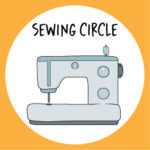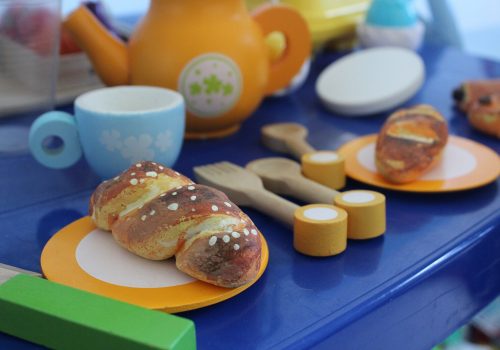Hand Sewing Stitches
Learn three different stitches: backstitch, slipstitch and whip stitch.
Backstitch
The backstitch is the very strongest stitch for hand sewing and is good to use if you are going to sew something and the “turn” it inside out.
Make a sample of the backstitch on green felt. Once finished, glue the sample to the Hand Sewing Stitch Sample in the student packet for your sewing binder.
The Back Stitch:
If you think of the little diagram above as the places where your needle goes in and out of the fabric, come up at A, down at B, up at C.
Then go backwards and go back down at B.
Come up at D.
Go down at C and up at E. Continue this pattern.
Go down at D and up at F. It is sort of like playing “leap frog.”
Go down at E and up at G. Finish by taking a few small stitches.
| Now do the back stitch. This stitch is confusing at first, but is very useful when you get good at it. Bring the thread up and then down in the fabric. Bring the thread up again as if you were doing the running stitch and pull the needle through the fabric. Instead of going forward, move backward and put the needle down exactly where the first stitch went down. Bring the needle up again in front of the place the needle came up before. Move backward and put the needle down where the previous stitch ended and repeat the pattern |
| º | º | º | º | º | º | º |
| G | F | E | D | C | B | A |
Slipstitch
The slipstitch is used to close up an opening up or sew a folded edge to a piece of fabric.
Make a sample of the sliptstitch on flowered fabric. Once finished, glue the sample to the Hand Sewing Stitch Sample in the student packet for your sewing binder.
The Slip Stitch:
Start by putting the needle inside the folded edge and bring it to the outside so that the knot is on the inside and doesn’t show.
Push the needle through both layers of folded fabric. You only need to catch a few threads on each piece. Pull the thread through.
Move the needle forward a tiny bit and take another stitch through both folded edges. If you picture the two folded edges as the sides of a ladder, the stitches will form the “rungs” of the ladder. Make your stitches pretty small. When you are done take several small stitches in the same place to secure your work.
| When you do something “right sides together”, then turn it inside out and stuff it you will have an opening that looks like this. |
| Pin the 2 sides together so that that folded edges are right next to each other. |
Whip Stitch
The Whipstitch is very much like the “slipstitch” and can be used to stitch two pieces of fabric together or to close up things that you’ve stuffed.
Make a sample of the whip stitch on blue felt. Once finished, glue the sample to the Hand Sewing Stitch Sample in the student packet for your sewing binder.
The Whip Stitch:
Like the running stitch, the whip stitch is also very easy. However they are very different.
If you think of the diagram above as the places your needle goes through the fabric, the whip stitch is made by pushing the needle up through the fabric at A. The thread wraps around the edge of the fabric and comes up through the fabric again at B. It wraps around the edge and comes up through the fabric at C. You continue that pattern until the finish your sewing.
When ever you hand sew you need to be careful and avoid some common mistakes.
| The Running Stitch | The Whip Stitch |
| The needles goes up and down into the fabric and never crosses around the edge. | The needle only goes up through the fabric—never back down and it always wraps around the edge of the fabric. |
| º | º | º | º | º | º | º |
| G | F | E | D | C | B | A |
- Always pull the thread all the way through your fabric so you don’t accidently leave loops on one side.
- Be careful to keep the thread from getting tangled up and knotted.
- Make sure that you go in and out of the fabric rather than around the edge (unless you are doing the whip stitch, and then make sure you go around the edge on every stitch!)
Try It Out
Pick an activity and try it out as a group or at home

Felt Food
Sew pretend food for a play house.

Is there a broken link or problem? Report it here.

Help Simply Smart build a community with free resources for families. Share lesson plan ideas!

- Date Added: April 1, 2024


